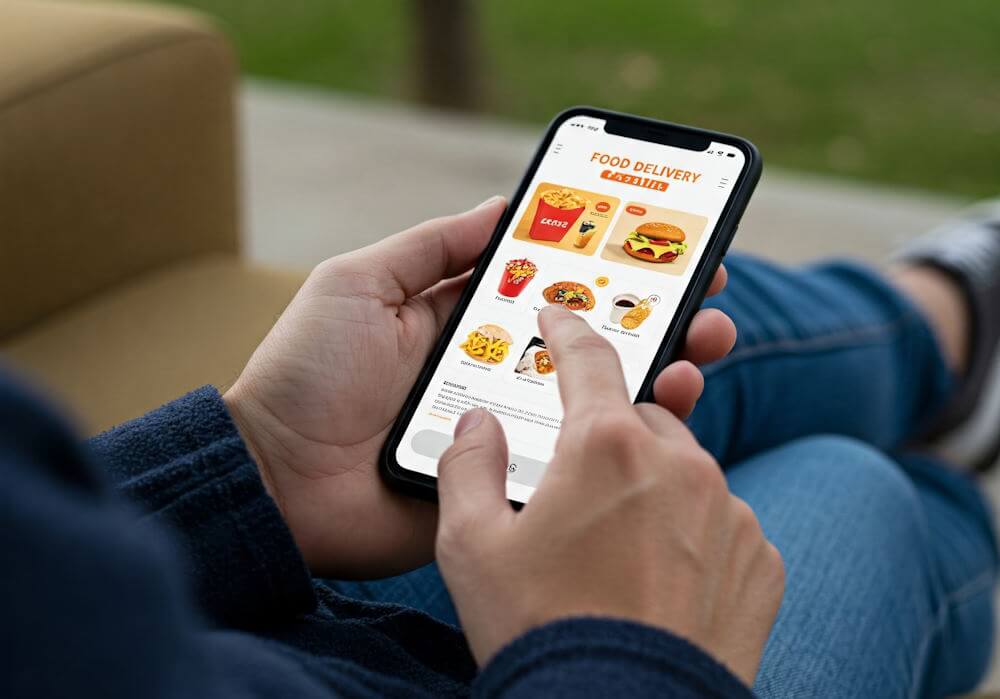The food delivery market has undergone significant transformations in recent years, driven by advancements in technology and shifting consumer behaviors. As a result, small restaurants are now navigating a landscape that is both fraught with challenges and rich in opportunities. The rise of food delivery services has changed the way consumers access dining options, creating a competitive environment where traditional brick-and-mortar establishments must adapt to survive.
The growing popularity of delivery platforms has made it easier for customers to order food from the comfort of their homes, leading to an increase in demand for quick and convenient meal options. However, this convenience comes at a price, as small restaurants must contend with the pressures of competing against larger chains that often have greater resources and marketing capabilities. The accessibility of delivery services has leveled the playing field in some respects, but it also means that small restaurants face the daunting task of distinguishing themselves amidst an influx of choices available to consumers.
Additionally, adapting to the food delivery trend is not solely about joining these platforms; it also requires reevaluating menu offerings, pricing strategies, and overall customer experience. Efficiency in operations and a strong online presence have become paramount as small establishments seek to capture their share of this rapidly growing market. Embracing technology, from online ordering systems to delivery logistics, is crucial for staying relevant in a world where customer preferences are increasingly oriented towards convenience.
In light of these developments, small restaurants must not only embrace food delivery as an essential part of their business model but also innovate to remain competitive. This means understanding market trends, consumer demands, and the unique challenges that come with operating within this dynamic environment. By strategically positioning themselves, small restaurants can leverage the opportunities presented by the food delivery market while effectively tackling the challenges they encounter.
Understanding the Food Delivery Landscape
The food delivery market has experienced a dramatic transformation over the past few years, influenced heavily by technological advancements and shifts in consumer behavior. Key players, including major delivery platforms like UberEats, DoorDash, and Grubhub, dominate the landscape, providing a wide array of options for consumers. These platforms have not only expanded the reach of restaurants but have also redefined consumer expectations regarding speed, variety, and convenience.
One significant trend is the increasing preference for online ordering over traditional dining options. Consumers are becoming more reliant on their smartphones for food choices; this shift has propelled the development of apps and services tailored to deliver meals with just a few taps. The ease of using these applications has led to higher demand for food delivery services, which has prompted many small restaurants to adapt their operations to meet these new consumer habits.
Emerging trends also indicate a noticeable interest in healthier and more sustainable food options. Restaurants that prioritize organic ingredients, locally sourced produce, or eco-friendly packaging tend to attract a growing segment of health-conscious consumers. The ability of small restaurants to cater to these preferences can significantly differentiate them from larger chains focused mainly on convenience. As the competitive landscape evolves, understanding the dynamics behind consumer trends—such as vegetarianism, veganism, and the growing popularity of meal kits—becomes crucial.
Moreover, the impact of technology extends beyond just delivery platforms. Innovations in order management systems, customer relationship management (CRM) tools, and data analytics enable small restaurants to optimize their operations and marketing strategies effectively. With the right analytics, these establishments can gain valuable insights into customer behaviors, preferences, and feedback, allowing them to refine their offerings continuously.
Understanding the current state of the food delivery market is vital for small restaurants looking to navigate this competitive space successfully. By recognizing key players, trends, and consumer preferences, these establishments can develop strategies that not only attract customers but also foster loyalty in a rapidly changing environment.
Leveraging Technology to Enhance Delivery Services
In today’s competitive food delivery market, small restaurants must utilize technology to improve their delivery operations. Implementing an efficient online ordering system is the first step for these establishments. Such systems enable customers to conveniently place their orders via websites or mobile applications, substantially enhancing the user experience. By offering a seamless ordering process, small restaurants can minimize wait times, reduce order errors, and increase customer satisfaction.
Moreover, the prevalence of mobile apps has transformed how consumers interact with restaurants. With a dedicated mobile application, small restaurants can foster brand loyalty by providing an intuitive interface for ordering food and accessing special promotions. Incorporating features such as push notifications about discounts or new menu items can drive customer engagement. Furthermore, data analytics from mobile apps can allow small restaurants to understand customer preferences and tailor their offerings accordingly.
Another technological advancement that small restaurants should embrace is efficient delivery tracking mechanisms. With the rise of delivery management platforms, restaurants can monitor their delivery processes in real time. These platforms provide visibility to both the restaurant and the customer regarding order status, estimated delivery times, and even driver location. This transparency not only enhances customer experience but also enables restaurants to optimize their delivery routes and resource allocation.
Integration of third-party delivery services is also a consideration for small restaurants. Partnering with established delivery platforms can expand a restaurant’s reach without significant investment in logistics. Utilizing these services enables small businesses to leverage the technology and customer base of larger players while focusing on their core competencies: delivering high-quality food.
Incorporating these technological tools and platforms into their operations can empower small restaurants to improve their delivery services, streamline processes, and enhance customer satisfaction.
Creating a Unique Selling Proposition (USP)
In a crowded food delivery market, a strong Unique Selling Proposition (USP) is essential for small restaurants to stand out and attract customers. The USP defines what makes a restaurant distinctive and compelling in comparison to larger competitors. Developing a memorable and appealing USP involves highlighting unique menu offerings, exceptional service, and the use of locally sourced ingredients.
One effective way to create a USP is by curating a menu that features signature dishes not commonly found in larger restaurant chains. This may involve focusing on niche cuisines, innovative meal combinations, or even seasonal specials that can pique consumer interest. For example, a small Italian eatery might offer artisanal pasta made from scratch using family recipes. This not only positions the restaurant as unique but also fosters a sense of tradition and authenticity that appeals to customers seeking distinct culinary experiences.
Another approach to differentiating a restaurant lies in the sourcing of ingredients. Emphasizing partnerships with local farmers and producers can enhance the quality of the menu while also supporting the community. By promoting these relationships, restaurants can convey a commitment to sustainability and freshness that resonates deeply with today’s environmentally conscious diners. Highlighting local sourcing in marketing materials can reinforce the restaurant’s connection to its community and position it favorably against larger chains that may lack such personalized elements.
Additionally, personalized service can be pivotal in establishing a strong USP. Small restaurants often have the advantage of being able to provide a more intimate dining experience, where staff members can engage with customers on a personal level. This remarkable attention to customer interaction builds loyalty and sets the restaurant apart from larger operations that may prioritize speed over customer relationship. By consistently delivering quality service and creating memorable interactions, small restaurants can cultivate a loyal customer base that appreciates their unique offerings and dedication to excellence.
Building Strong Relationships with Delivery Partners
In the increasingly competitive food delivery market, small restaurants must actively pursue strong relationships with food delivery partners. These partnerships are crucial, as they can significantly influence a restaurant’s reach and customer satisfaction. Establishing a collaborative relationship with delivery services can help optimize delivery performance while enhancing the overall experience for diners.
One effective strategy is to negotiate favorable terms that align with the restaurant’s operational goals. When engaging with delivery partners, it is essential to discuss commission rates, delivery zones, and payment structures openly. By understanding each party’s needs and constraints, small restaurants can leverage their unique value propositions. For instance, restaurants can emphasize their local appeal or distinctive menu items to foster a stronger negotiating position. Ensuring that terms are beneficial to both parties will lead to a more cooperative and productive partnership.
Collaboration on promotional campaigns can further strengthen these relationships. Joint marketing efforts not only help increase visibility for the restaurant but also provide delivery partners with fresh content to share with their customer base. Restaurants might consider creating special offers that are exclusive to customers using specific delivery platforms. Such promotions can increase traffic and orders during slow periods, offering mutual benefits to both the restaurant and the delivery service.
Another key aspect of building strong relationships with delivery partners lies in maintaining effective communication. Regular check-ins and feedback sessions can help address any operational issues promptly while ensuring that both parties remain aligned on objectives. Encouraging transparency allows for quick resolution of challenges and paves the way for a more resilient partnership. By prioritizing these strategies, small restaurants can effectively navigate the food delivery market and enhance their overall success.
Marketing Strategies for Food Delivery Success
In the competitive landscape of the food delivery market, small restaurants must leverage effective marketing strategies to promote their services successfully. One significant approach is social media marketing. Restaurants can utilize platforms like Instagram, Facebook, and Twitter to showcase their unique menu items and engage with customers. High-quality images of dishes, stories of ingredients, and customer testimonials can be powerful content to attract both new and returning diners. Regularly updating followers with promotions, delivery specials, and limited-time offers can further drive interest and engagement.
Another crucial strategy involves optimizing for local search engine optimization (SEO). Small restaurants should ensure that their website and online listings are optimized with relevant keywords that potential customers might use to find food delivery options in their area. This includes incorporating local keywords throughout website content and ensuring that Google My Business profiles are complete and accurate. Additionally, encouraging satisfied customers to leave positive reviews online can enhance local SEO efforts, making it more likely for the restaurant to appear in relevant search results.
Establishing partnerships with local influencers presents another viable marketing tactic. Influencers with a strong local presence can effectively introduce a restaurant’s delivery service to a wider audience, especially when they share enticing reviews and vibrant photographs of menu items. Collaborations can also extend to food bloggers and local community events, where restaurants can showcase their offerings and generate buzz around their delivery options.
Lastly, crafting appealing promotions is essential for capturing the attention of potential customers. Offering discounts on the first order, free delivery over a certain amount, or loyalty rewards for repeat customers can motivate diners to try the delivery service. Tailoring promotions to resonate with specific target audiences can enhance their effectiveness and drive sales.
Quality Control and Customer Experience
In the competitive landscape of the food delivery market, maintaining high food quality and exceptional customer service is paramount for small restaurants. When food is not consumed on-site, the challenges of preserving freshness and taste become vital. Ensuring that meals retain their intended flavor and temperature during transit is essential. This can be achieved by investing in quality packaging materials that provide insulation and protect dishes from spillage.
Furthermore, it’s beneficial for restaurants to establish standardized cooking procedures to guarantee consistency. Each dish should embody the same quality, whether consumed in-house or delivered. This consistency fosters customer satisfaction and enhances brand loyalty, ultimately leading to repeat business. Regular training sessions for staff on preparation and packaging can significantly improve the quality control process.
Timely deliveries play a critical role in customer experience. Small restaurants must strive to optimize their operations to ensure that orders are dispatched promptly. This could involve implementing a routing system for delivery drivers to minimize wait times or using reliable delivery services that align with the restaurant’s standards. Efficient delivery ensures that the food arrives at its peak condition, which directly influences customer satisfaction.
Engaging with customers post-delivery is equally vital. Encouraging feedback allows restaurants to assess their performance and identify areas for improvement. Utilizing platforms such as social media or a dedicated feedback form can facilitate this process. Positive reviews boost visibility and attract new customers, while constructive criticism offers valuable insights for enhancing the delivery experience.
In conclusion, small restaurants can thrive in the food delivery market by prioritizing food quality and customer service. By focusing on effective packaging, timely deliveries, and actively seeking customer feedback, they can ensure a positive dining experience that encourages loyalty and supports sustainable growth.
Pricing Strategies for Competitive Advantage
In the highly competitive food delivery market, small restaurants face the challenge of setting prices that both attract customers and ensure profitability. Striking the right balance in pricing is crucial, as it directly impacts overall market positioning and customer perception. To effectively navigate this landscape, it is essential to develop a comprehensive pricing strategy that encompasses menu pricing, delivery fees, and promotional offers.
Menu pricing, the cornerstone of a restaurant’s pricing strategy, should be reflective of food cost while considering competitor pricing. Small restaurants should evaluate the pricing structure of similar offerings in their locality to ensure competitiveness. This research can inform decisions on whether to adopt a cost-plus pricing model, which incorporates a set profit margin over costs, or a value-based pricing approach that aligns with customers’ perceived value of the dining experience. Identifying unique selling propositions, such as exclusive dishes or locally sourced ingredients, can also justify higher price points.
In addition to menu prices, delivery fees play a pivotal role in shaping customer expectations and satisfaction. Small restaurants should carefully determine a delivery fee that balances operational costs with customer willingness to pay. Implementing free delivery for orders above a certain threshold can encourage larger purchases while fostering customer loyalty. Moreover, flexible pricing options, such as discounted delivery fees during off-peak hours, can attract diverse customer segments.
Special promotions are another effective technique for small restaurants to maintain a competitive edge without compromising profitability. For instance, offering limited-time discounts or bundle deals can stimulate sales while creating a sense of urgency among customers. Incorporating loyalty programs that reward repeat customers with exclusive offers can further enhance customer retention and drive long-term profitability. In this rapidly evolving food delivery landscape, a well-considered pricing strategy is vital for small restaurants striving to thrive and compete effectively.
Conclusion and Future Trends
As the food delivery market continues to evolve, small restaurants must remain agile and ready to adapt to shifting consumer preferences and technological advancements. Throughout this discussion, we have emphasized the necessity for small eateries to leverage local niches, enhance their online presence, and establish reliable partnerships with delivery platforms. By focusing on quality, unique offerings, and effective marketing strategies, small restaurants have the potential to carve out a significant share of the competitive food delivery landscape.
Looking ahead, several trends are likely to shape the food delivery industry. First, the rise of sustainability in consumer choices may drive small restaurants to adopt eco-friendly practices. Utilizing biodegradable packaging and sourcing ingredients locally can appeal to environmentally conscious customers, enhancing brand loyalty. Additionally, the integration of technology will remain pivotal in streamlining operations; restaurants that utilize advanced ordering systems, artificial intelligence for personalized recommendations, and efficient route optimization stand to improve their service efficiency and customer satisfaction.
Furthermore, the growing popularity of meal kits and customized dining experiences suggests that small restaurants should consider diversifying their offerings. This could range from providing DIY meal kits that allow customers to prepare meals at home, to unique themed dining nights that attract guests looking for novel experiences. Engaging with the community through events, collaborations, and local sourcing not only fosters customer loyalty but also strengthens the restaurant’s role in the local ecosystem.
In conclusion, small restaurant owners must embrace flexibility and innovation as they navigate the complexities of the food delivery market. By staying updated on consumer trends and continuously refining their offerings, they can maintain a competitive edge. The future holds tremendous opportunities for those willing to adapt and innovate, ensuring long-term success in the vibrant food delivery landscape.





